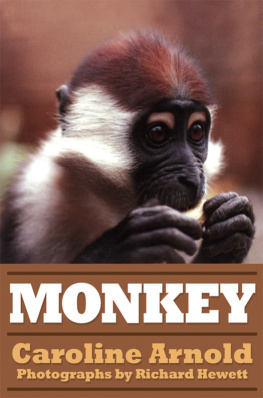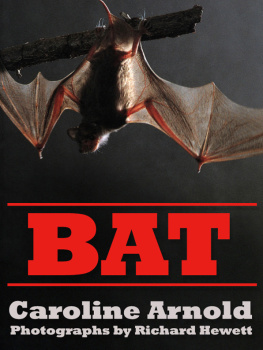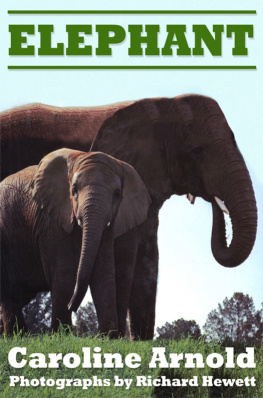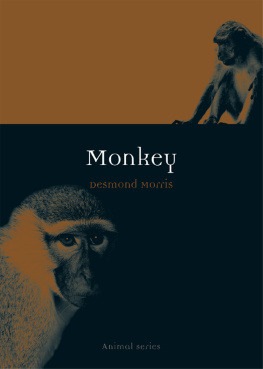

CONTENTS


Guide
Text copyright 2013, 1993 by Caroline Arnold. Photographs copyright 2013, 1993 by Richard Hewett. All rights reserved.
Published by Seymour Science LLC
Printed edition originally published in 1993 by William Morrow and Company
Except in the case of brief quotations embodied in critical reviews and articles, no part of this book may be used or reproduced in any manner whatsoever without written permission from the publisher. Contact: Starwalk Kids Media, 15 Cutter Mill Road, Suite 242, Great Neck, NY 11021
www.StarWalkKids.com
ISBN 978-1-623345-25-9
The Library of Congress has cataloged the printed edition as follows: Arnold, Caroline. Monkey / Caroline Arnold ; photographs by Richard Hewett. Summary: Describes the physical characteristics, habits, behavior, natural environment, and zoo life of the red-crowned mangabey monkey.
ISBN 0-688-11342-7 (trade).ISBN 0-688-11343-5 (library) 1. Red-crowned mangabeyJuvenile literature. [1. Red-crowned mangabey. 2. Monkeys.] I. Hewett, Richard, ill. II Title.




ACKNOWLEDGMENTS
We are thankful for all the help we received on this project from the Los Angeles Zoo. We are especially grateful to June Bottcher, Special Programs Assistant; Jennie McNary, Senior Animal Keeper; and Robin Noll and Kelley Walsh, Animal Keepers, for their cheerful cooperation and willingness to answer our questions. We also thank Bob Barnes, Curator of Mammals, Los Angeles Zoo; Dr. Peter Waser, Purdue University; and Dr. John Oates, Hunter College, for their expert advice. And, as always, we thank our editor, Andrea Curley, for her continued enthusiastic support.
Leaping lightly on long, strong limbs, the young monkey jumped onto a fallen log. Although he was not yet fully grown, one-year-old Little Dude was nearly as agile as the older monkeys in his group. Always curious, he leaned forward to see what his mother had found. In her hands was a juicy slice of apple, one of Little Dudes favorite foods. She broke off a piece and gave it to him. Now he could have a taste, too.
Little Dude and his mother are a kind of monkey called the red-crowned mangabey. Together with three others of their species, they live in an enclosure at the Los Angeles Zoo in California. The keepers know each of the monkeys well and have given them names. In addition to Little Dude and his mother, Red, their group includes two adult females, Tip and Stub, and one adult male named Guy.






Although they are far from their native home in the coastal rain forests of West Africa, the group of red-crowned mangabeys at the zoo are comfortable and receive good care from the zoo staff. In their spacious enclosure the monkeys have ropes and poles for climbing, ledges and platforms for resting, and plenty of food and water.
Monkeys are always one of the most popular animals at zoos. Their lively behavior and obvious intelligence make them both fun and interesting to watch. In their natural habitat, most monkeys are difficult to study. They move quickly and can barely be seen when they are in the treetops or behind shrubbery. But by observing them in zoos we can learn more about them and better understand how their behavior and physical characteristics help them to live in their natural environment.


One reason that monkeys are so fascinating is the wide variety of ways that different species look and behave. If you have the chance to observe other monkey species at a zoo or animal park, try to see how they resemble or differ from red-crowned mangabeys. Red-crowned mangabeys are similar in many ways to other monkeys, especially to those that are closely related to them. However, the details of their life-style are unique to their species.
The red-crowned mangabey is a large long-tailed monkey with a long muzzle, slender body, and long limbs. Its most distinctive feature is the cap of bright russet fur on top of the head. The short, thick fur on the monkeys body is dark gray on its back and legs and white on its chest and belly. Its tail is gray, with a tuft of white hair at the end. Because of the collar, or ring, created by its white cheeks and the white patch of fur on the back of its neck, this species is also sometimes called the white-collared mangabey. Except for the light-colored skin above its eyes, the skin of the red-crowned mangabey is black.
A special characteristic of the red-crowned mangabey is that it usually carries its tail up and curved over its back when walking. By raising or lowering the tail or by tapping its head with the tip of the tail, the monkey can convey signals to other members of its group.
In the wild, the red-crowned mangabey lives in Africa from Nigeria in the west to the Congo River in the east. It spends most of its time in rain forests and swamplands, moving constantly in search of food. Some red-crowned mangabeys live in national parks or forest reserves. However, the numbers of those that do not live in protected areas are shrinking because their forest habitat is being destroyed for logging and agriculture. Because places to live and sources of food are disappearing, the red-crowned mangabey is in danger of extinction.


























